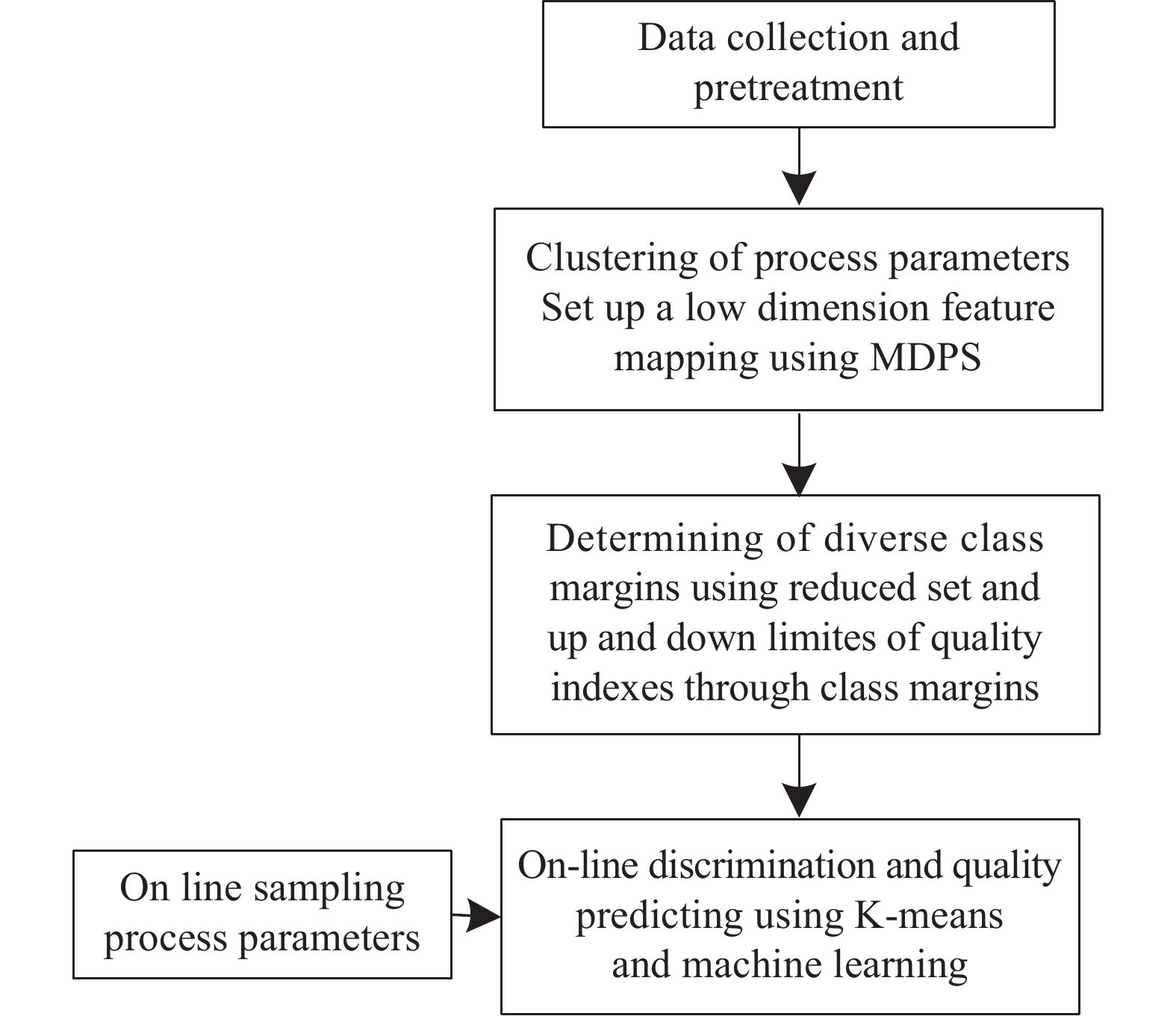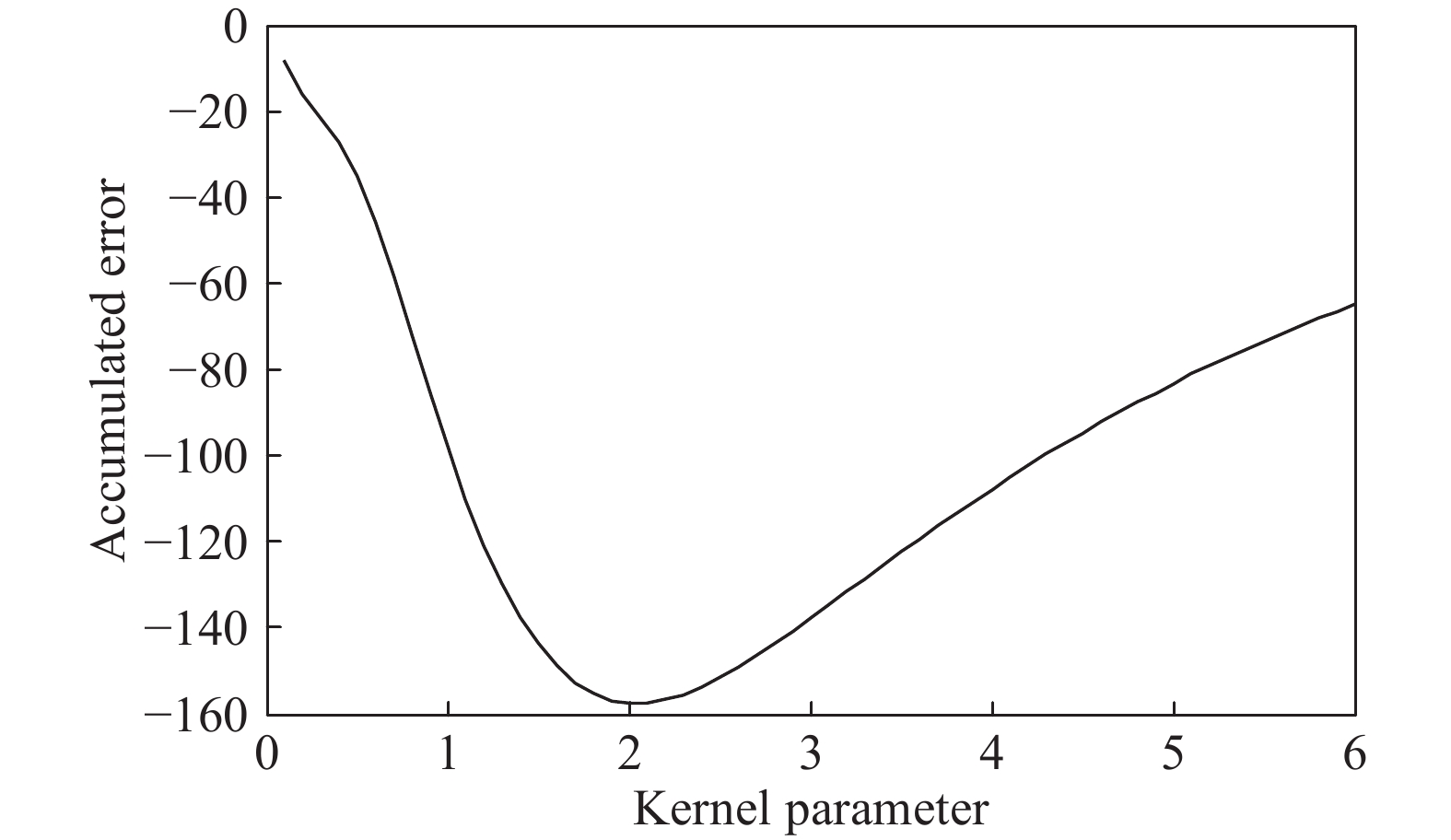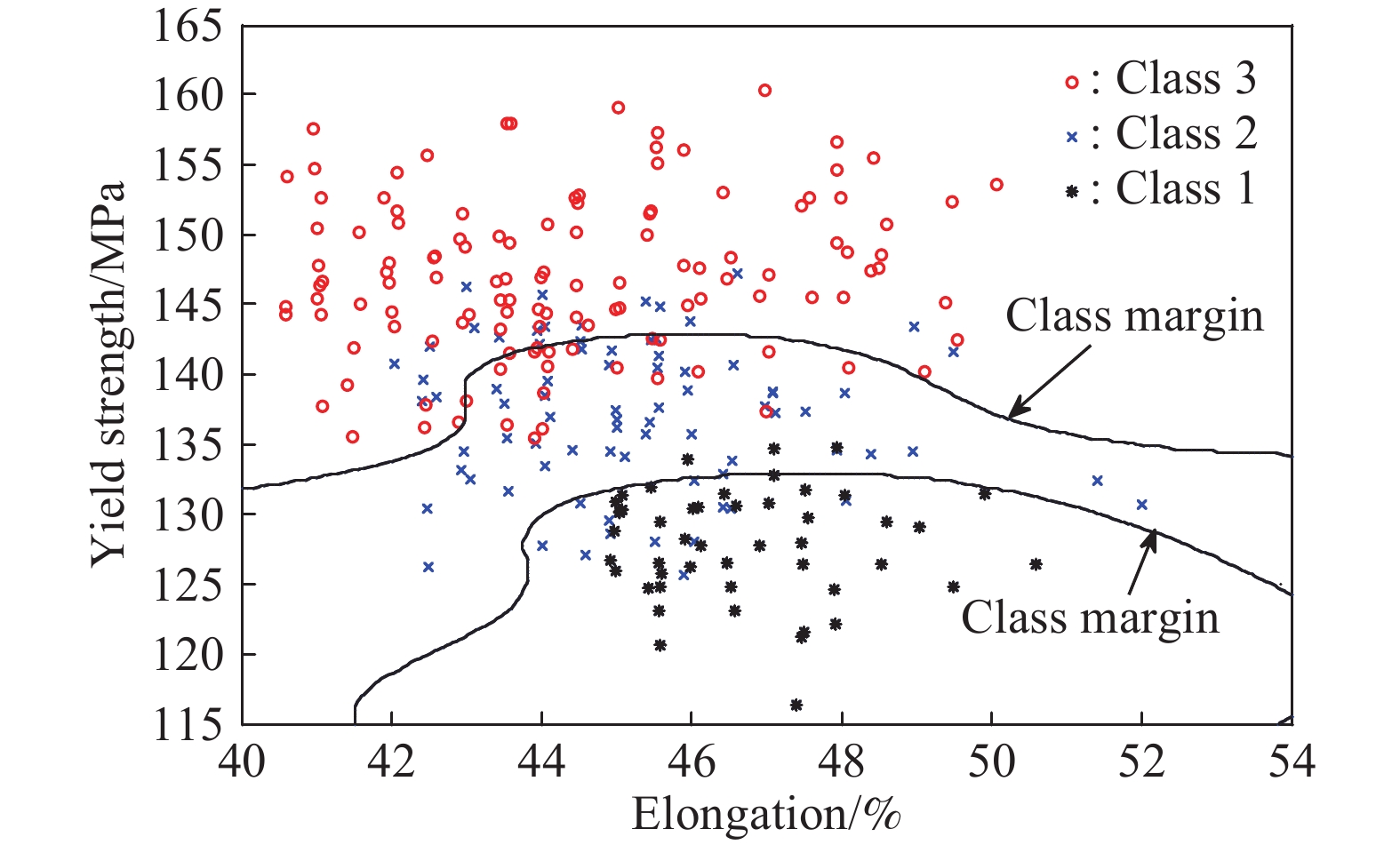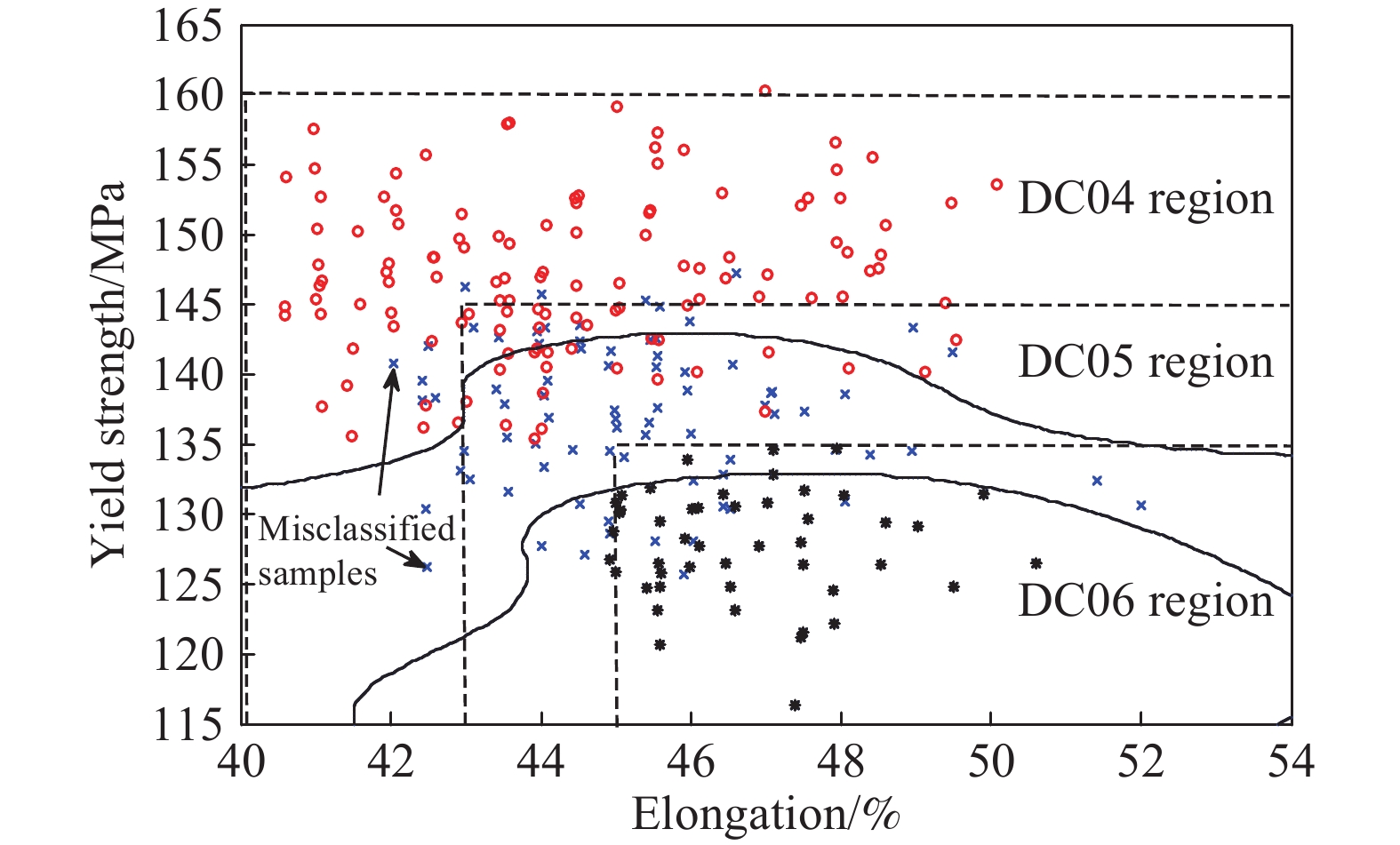Application of machine learning in automatic discrimination of product quality of deep drawn steel
-
摘要: 在流程工業中,生產過程需根據客戶對產品質量要求進行判級,以滿足客戶提出的產品質量需求。目前,企業主要采用“事后”抽檢方式,但因無法對所有產品實現在線自動判級,常發生索賠和退貨,導致我國鋼鐵企業每年近100億元損失。為了實現產品質量在線自動判級,提出基于高維數據非線性同等縮放與核簡支集類邊界確定相結合的質量在線智能判級方法。首先,將高維的工藝參數通過非線性同等縮放算法變換成低維的數據集,并對縮放后數據集進行聚類,分析工藝參數的類分布特征。然后,根據分類后樣本的質量指標值分布,采用核簡支集類邊界算法來確定不同產品質量級別的類邊界。最后,依據已確定的類邊界,通過質量指標預測實現產品在線判級。通過深沖鋼(IF鋼)應用實例,證實該方法在訓練階段的在線自動判級準確率達到97.2%,測試階段的準確率為96%。Abstract: In process industries, the discrimination of final product quality must be implemented in the manufacturing process. At present, the primary method is “after spot test ward,” but there is no other way to realize online automatic discrimination for all products, which frequently leads to customer return purchases and complaints about the product quality, and annual economic loss of 10 billion Yuan in Chinese steel enterprises. This paper proposed online product quality automatic discrimination method based on machine learning to realize online automatic discrimination for all products. First, multidimensional process parameters were mapped into a low-dimensional data set using nonlinear multidimensional parity scaling (MDPS), and the data set is clustered. The distribution feature in the data set was analyzed. The quality index values were then transformed into a low-dimensional map with the class labels determined by process parameter clustering, and the diverse class margins were determined using a support vector machine (SVM) with L2-soft margins. The kernel method set was used to reduce the number of support vectors to simplify the class boundary, and the reduced set determined the actual class margins. Finally, the quality indexes were predicted using machine learning algorithms, such as back-propagation network (BPN), long short-team memory (LSTM), kernel partial least squares (KPLS), and k-nearest neighbors (KNN), including the online automatic discrimination of product quality was realized using the determined class margins and the predicted values of quality indexes. The accuracy of the online automatic discrimination of steel types is up to 97% in the training stage and up to 96% in the testing stage based on industrial production data of interstitial-free (IF) steel.
-
表 1 主要工藝參數名稱及統計值
Table 1. Major process parameters and statistics
Parameter name Max Min Mean Variance Mass fraction of C/% 0.0028 0.0011 0.0018 0.0004 Mass fraction of Mn/% 0.160 0.09 0.1263 0.0154 Mass fraction of P/% 0.014 0.007 0.0099 0.0019 Mass fraction of S/% 0.0139 0.0061 0.00766 0.0019 Exit temperature of heating furnace/°C 1277.30 1247.10 1263.04 5.998 Entry temperature of finish
rolling/°C1083.94 1014.03 1039.08 9.804 Exit temperature of finish
rolling/°C928.46 898.68 917.17 4.167 Coiling temperature/°C 755.40 654.45 711.70 41.358 Cold-rolled reduction ratio/% 82.90 65.50 80.49 4.139 Heating temperature/°C 854.27 786.96 821.91 12.498 Soaking temperature/°C 854.97 789.66 824.27 12.352 Fast-cooling exit temperature/°C 455.73 299.84 431.13 24.296 Aging exit temperature/°C 394.12 287.12 374.52 12.299 Slow-cooling exit temperature/°C 676.39 605.97 641.61 11.280 表 2 汽車鋼性能指標的行標/企業內標
Table 2. Industry/internal standard of performance index of interstitial-free steel
Type Yield strength/MPa Tensile strength/MPa Elongation/% Plastic strain ratio DC04 210/(135?160) (270?350)/
(260?350)38/(40?44) 1.7/2.1 DC05 180/(125?150) (270?330)/
(250?330)40/(43?46) 2.0/2.2 DC06 170/(120?140) (270?330)/
(250?330)41/(45?48) 2.1/2.4 表 3 三種方法工藝參數類中心/類內方差數據
Table 3. Class center/ mean square error of quality indexes using three methods
Quality indexes Class1(DC06) Class2(DC05) Class3(DC04) Yield strength/MPa CPA 134.85/8.04 141.65/7.63 147.30/6.26 KCPA 127.53/5.55 138.83/7.77 143.37/8.26 MDPS 127.53/5.55 135.62/6.03 146.81/6.45 Tensile strength/MPa CPA 287.5/6.67 290.01/8.20 295.40/8.16 KCPA 280.2/6.30 292.10/7.45 291.58/7.48 MDPS 280.2/6.30 289.71/5.64 293.7/8.31 Elongation/% CPA 45.73/1.94 44.88/2.32 44.26/2.52 KCPA 46.45/1.77 44.69/2.18 45.13/2.36 MDPS 46.45/1.77 45.54/1.99 44.44/2.42 Plastic strain ratio CPA 2.93/0.200 2.83/0.218 2.74/0.200 KCPA 3.02/0.148 2.87/0.194 2.81/0.231 MDPS 3.02/0.148 2.91/0.195 2.76/0.200 中文字幕在线观看表 4 不同判級和性能預測方法的計算結果
Table 4. Calculating results of discrimination and predicting quality index using different methods
Methods Accuracy/
%Standard deviation Elongation/% Yield strength/
MPaTensile strength/
MPaPlastic strain ratio BP 91.5 1.9 5.09 4.54 0.2 LSTM 93.5 1.05 3.99 3.03 0.1 KPLS 90.7 1.78 5.35 5.57 0.16 PLS 82.1 1.94 5.77 5.38 0.19 KNN 90.1 2.05 6.28 5.78 0.19 Synthesis 96 — — — — -
參考文獻
[1] Chai T Y. Industrial process control systems: Research status and development direction. Sci Sin (Informationis) , 2016, 46(8): 1003柴天佑. 工業過程控制系統研究現狀與發展方向. 中國科學:信息科學, 2016, 46(8):1003 [2] Gehrmann C, Gunnarsson M. A digital twin based industrial automation and control system security architecture. IEEE Trans Ind Inform, 2020, 16(1): 669 doi: 10.1109/TII.2019.2938885 [3] China Electronics Standardization Institute. Hargrove grindability index of the coal blended [J/OL]. Website Online (2007-03-02) [2022-02-22]. http://www.cesi.cn/201703/2251.html中國電子技術標準化研究院. 信息物理系統白皮書(2017) [J/OL]. 網絡在線 (2007-03-02) [2022-02-22]. http://www.cesi.cn/201703/2251.html [4] Wang L H, T?rngren M, Onori M. Current status and advancement of cyber-physical systems in manufacturing. J Manuf Syst, 2015, 37: 517 doi: 10.1016/j.jmsy.2015.04.008 [5] Zhang C X, Cheng L L, Wang X D. Research on architecture of intelligent manufacturing based on cyber-physical system. Comput Sci, 2013, 40(Supple 1): 37張彩霞, 程良倫, 王向東. 基于信息物理融合系統的智能制造架構研究. 計算機科學, 2013, 40(S1): 37 [6] Xu G. Application Research of CPS in On-Line Quality Control to Metallurgical Products [Dissertation]. Beijing: University of Science and Technology Beijing, 2019徐鋼. CPS在冶金產品質量在線管控中應用研究[學位論文]. 北京: 北京科技大學, 2019 [7] Michniewicz J, Reinhart G. Cyber-Physical-Robotics - Modelling of modular robot cells for automated planning and execution of assembly tasks. Mechatronics, 2016, 34: 170 doi: 10.1016/j.mechatronics.2015.04.012 [8] Penas O, Plateaux R, Patalano S, et al. Multi-scale approach from mechatronic to Cyber-Physical Systems for the design of manufacturing systems. Comput Ind, 2017, 86: 52 doi: 10.1016/j.compind.2016.12.001 [9] Pirvu B C, Zamfirescu C B, Gorecky D. Engineering insights from an anthropocentric cyber-physical system: A case study for an assembly station. Mechatronics, 2016, 34: 147 doi: 10.1016/j.mechatronics.2015.08.010 [10] Morgan J, O’Donnell G E. Multi-sensor process analysis and performance characterisation in CNC turning—a cyber physical system approach. Int J Adv Manuf Technol, 2017, 92(1-4): 855 doi: 10.1007/s00170-017-0113-8 [11] Tao F, Cheng J F, Qi Q L. IIHub: an industrial Internet-of-things hub toward smart manufacturing based on cyber-physical system. IEEE Trans Ind Inform, 2018, 14(5): 2271 doi: 10.1109/TII.2017.2759178 [12] Gehrmann C, Gunnarsson M. A digital twin based industrial automation and control system security architecture. IEEE Trans Ind Inform, 2020, 16(1): 669 doi: 10.1109/TII.2019.2938885 [13] Wang J J, Ye L K, Gao R X, et al. Digital Twin for rotating machinery fault diagnosis in smart manufacturing. Int J Prod Res, 2019, 57(12): 3920 doi: 10.1080/00207543.2018.1552032 [14] Knapp G L, Mukherjee T, Zuback J S, et al. Building blocks for a digital twin of additive manufacturing. Acta Mater, 2017, 135: 390 doi: 10.1016/j.actamat.2017.06.039 [15] Barricelli B R, Casiraghi E, Fogli D. A survey on digital twin: Definitions, characteristics, applications, and design implications. IEEE Access, 2019, 7: 167653 doi: 10.1109/ACCESS.2019.2953499 [16] Lin Z Q, Lai X M, Jin S, et al. Digital methods of complex product manufacturing precision control and its development trend. J Mech Eng, 2013, 49(6): 103 doi: 10.3901/JME.2013.06.103林忠欽, 來新民, 金隼, 等. 復雜產品制造精度控制的數字化方法及其發展趨勢. 機械工程學報, 2013, 49(6):103 doi: 10.3901/JME.2013.06.103 [17] Xu G, Zhang X T, Li M, et al. Online monitoring and control method of product quality based on embedded cyber-physical system models. J Mech Eng, 2017, 53(12): 94 doi: 10.3901/JME.2017.12.094徐鋼, 張曉彤, 黎敏, 等. 基于嵌入式CPS模型的產品質量在線管控方法. 機械工程學報, 2017, 53(12):94 doi: 10.3901/JME.2017.12.094 [18] Xu G, Zhang X T, Li M, et al. A method of establishing process specifications in process industry based on statistical process control. J Mech Eng, 2019, 55(8): 208 doi: 10.3901/JME.2019.08.208徐鋼, 張曉彤, 黎敏, 等. 基于統計過程控制的流程工業工藝規范制定方法. 機械工程學報, 2019, 55(8):208 doi: 10.3901/JME.2019.08.208 [19] Xu G, Li M, Xu J W. Application research of on-line quality control method to metallurgical products // 2019 IEEE International Conference on Industrial Engineering and Engineering Management. Macao, 2019: 390 [20] Morgan D, Jacobs R. Opportunities and challenges for machine learning in materials science. Annu Rev Mater Res, 2020, 50: 71 doi: 10.1146/annurev-matsci-070218-010015 [21] Arróyave R, McDowell D L. Systems approaches to materials design: Past, present, and future. Annu Rev Mater Res, 2019, 49: 103 doi: 10.1146/annurev-matsci-070218-125955 [22] Rosenbrock C W, Gubaev K, Shapeev A V, et al. Machine-learned interatomic potentials for alloys and alloy phase diagrams. Npj Comput Mater, 2021, 7: 24 doi: 10.1038/s41524-020-00477-2 [23] Fan Y S, Yang X G, Shi D Q, et al. Quantitative mapping of service process-microstructural degradation-property deterioration for a Ni-based superalloy based on chord length distribution imaging process. Mater Des, 2021, 203: 109561 doi: 10.1016/j.matdes.2021.109561 [24] Hart G L W ", Mueller T, Toher C, et al. Machine learning for alloys. Nat Rev Mater, 2021, 6(8): 730 doi: 10.1038/s41578-021-00340-w [25] Kondo R, Yamakawa S, Masuoka Y, et al. Microstructure recognition using convolutional neural networks for prediction of ionic conductivity in ceramics. Acta Mater, 2017, 141: 29 doi: 10.1016/j.actamat.2017.09.004 [26] Wang C, Shi D Q, Li S L. A study on establishing a microstructure-related hardness model with precipitate segmentation using deep learning method. Materials, 2020, 13(5): 1256 doi: 10.3390/ma13051256 [27] Kipf T, Welling M. Semi-supervised classification with graph convolutional networks.https://doi.org/10.48550/arXiv.1609.02907 [28] Cao N D, Kipf T. MolGAN: An implicit generative model for small molecular graphs.https://doi.org/10.48550/arXiv.1805.11973 [29] Shawe-Taylor J, Cristianini N. Kernel Methods for Pattern Analysis. Cambridge: Cambridge University Press, 2004 [30] Cutkosky A, Orabona F. Black-box reductions for parameter-free online learning in Banach spaces.https://doi.org/10.48550/arXiv.1802.06293 [31] Mesbah A. Stochastic model predictive control: An overview and perspectives for future research. IEEE Control Syst Mag, 2016, 36(6): 30 doi: 10.1109/MCS.2016.2602087 -




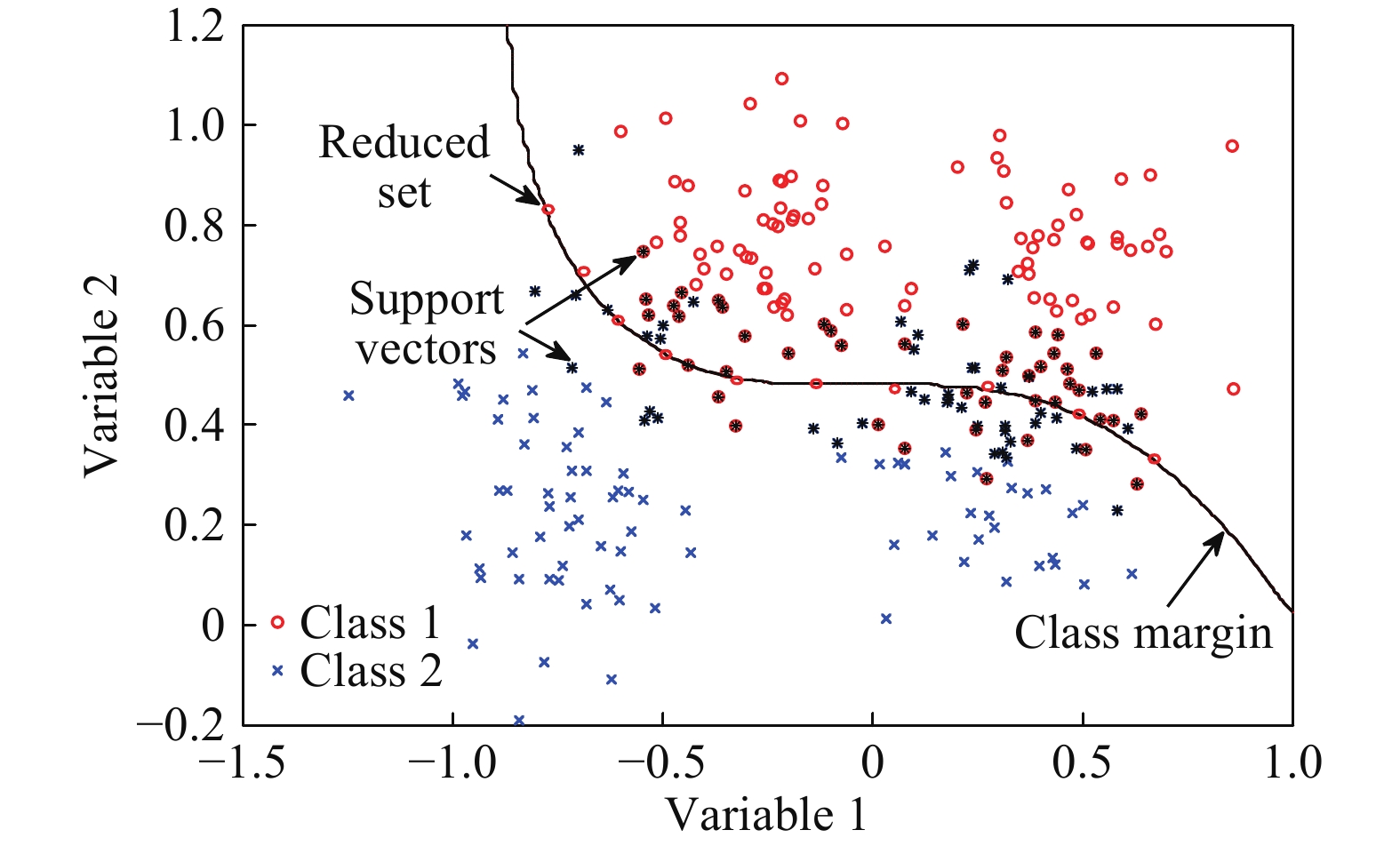
 下載:
下載:
